Spring管理Bean-IOC-04 3.基於註解配置bean 3.1基本使用 3.1.1說明 基本說明:基於註解的方式配置bean,主要是項目開發中的組件,比如Controller,Service和Dao 組件的註解形式有: @Component 表示當前註解標識的是一個組件 @Controll ...
Spring管理Bean-IOC-04
3.基於註解配置bean
3.1基本使用
3.1.1說明
基本說明:基於註解的方式配置bean,主要是項目開發中的組件,比如Controller,Service和Dao
組件的註解形式有:
@Component表示當前註解標識的是一個組件@Controller表示當前註解標識的是一個控制器,通常用於Servlet@Service表示當前註解標識的是一個處理業務邏輯的類,通常用於Service類@Repository表示當前註解標識的是一個持久化層的類,通常用於Dao類
3.1.2快速入門
應用案例:使用註解的方式來配置Controller /Service/ Repository/ Component
代碼實現:
1.使用註解方式,需要引入spring-aop.jar包,該jar包位於spring/lib下
2.創建 UserAction.java、UserService.java、UserDao.java、MyComponent.java
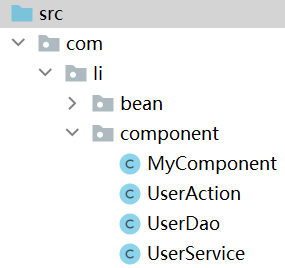
UserDao:
package com.li.component;
import org.springframework.stereotype.Repository;
/**
* @author 李
* @version 1.0
* 使用 @Repository 表示該類是一個Repository,一個持久化層的類/對象
*/
@Repository
public class UserDao {
}
UserService:
package com.li.component;
import org.springframework.stereotype.Service;
/**
* @author 李
* @version 1.0
* @Service 標識該類是一個Service類/對象
*/
@Service
public class UserService {
}
UserAction:
package com.li.component;
import org.springframework.stereotype.Controller;
/**
* @author 李
* @version 1.0
* @Controller 標識該類是一個控制器Controller,通常該類是一個Servlet
*/
@Controller
public class UserAction {
}
MyComponent:
package com.li.component;
import org.springframework.stereotype.Component;
/**
* @author 李
* @version 1.0
* @Component 用於標識該類是一個組件,是一個通用的註解
*/
@Component
public class MyComponent {
}
上面我們在類中添加了註解,但是還沒有在配置文件中指定容器要掃描哪個包下的註解類
3.配置beans04.xml:
<!--配置容器要掃描的包:
1.component-scan 表示對指定的包下的類進行掃描,並創建對象到容器
2.base-package 指定要掃描的包
3.下麵整個配置的含義是:當spring容器創建/初始化時,會掃描 com.li.component 包下
的所有含有四種註解(Controller/Service/Repository/Component)的類,
並將其實例化,生成對象,放入到ioc容器
-->
<context:component-scan base-package="com.li.component"/>
註意引入context命名空間
4.測試
//通過註解來配置Bean
@Test
public void setBeanByAnnotation() {
ApplicationContext ioc = new ClassPathXmlApplicationContext("beans04.xml");
System.out.println("ok");
}
在 System.out.println("ok");旁打上斷點,點擊debug。
查看ioc對象-->beanFactory-->singletoObjects-->table的屬性。因為table屬性有很多null值,為了顯示方便,這裡配置了IDEA不顯示null值
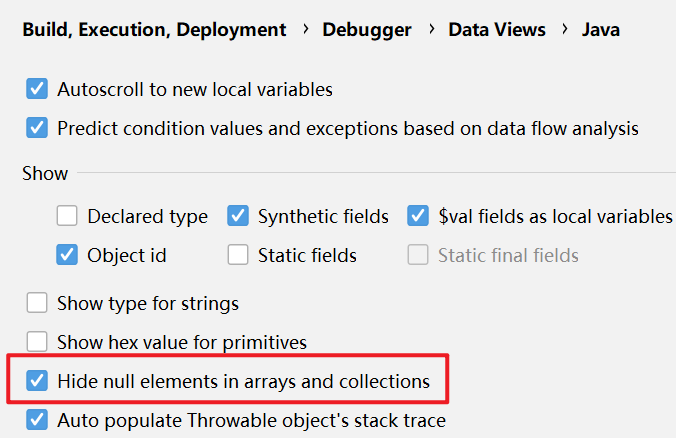
如下,spring容器中成功創建了四個對象,並且在預設情況下,按照註解方式進行掃描創建的對象,它對應的id就是它的類名(首字母小寫)
其他的對象是系統自帶的
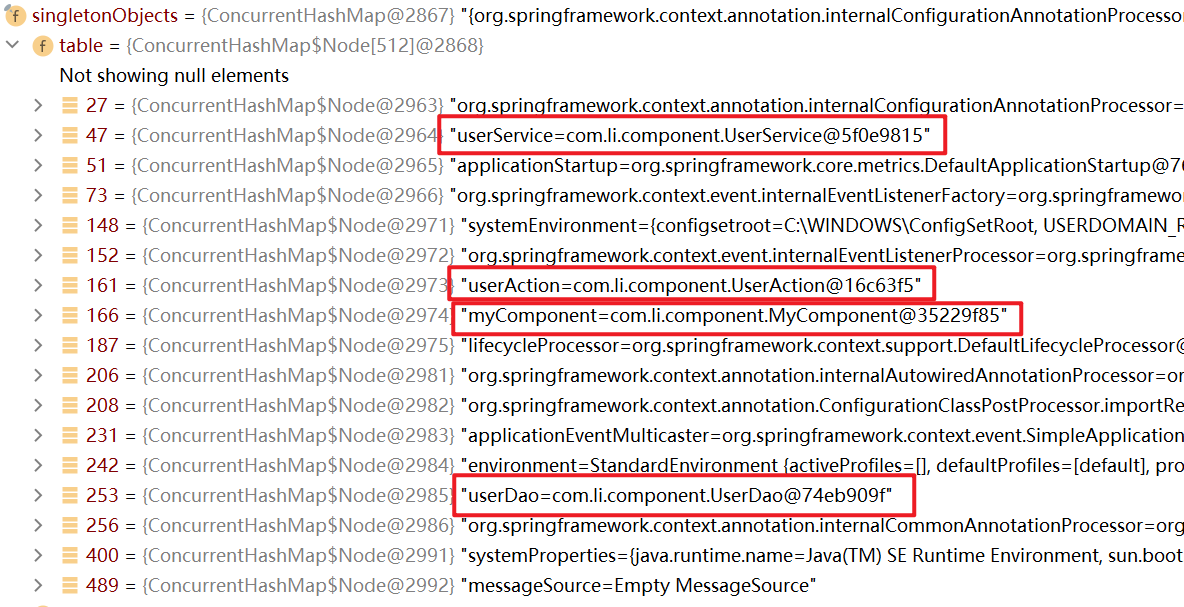
查看類型id(key)

因為配置的這四個對象是單例對象,因此可以直接通過類的類型來獲取:
因為spring在創建時賦予了預設id,也可以通過id來獲取
//通過註解來配置Bean
@Test
public void setBeanByAnnotation() {
ApplicationContext ioc = new ClassPathXmlApplicationContext("beans04.xml");
UserDao userDao = ioc.getBean(UserDao.class);
UserService userService = ioc.getBean(UserService.class);
UserAction userAction = ioc.getBean(UserAction.class);
MyComponent myComponent = ioc.getBean(MyComponent.class);
System.out.println("userDao=" + userDao);
System.out.println("userService=" + userService);
System.out.println("userAction=" + userAction);
System.out.println("myComponent=" + myComponent);
System.out.println("ok");
}
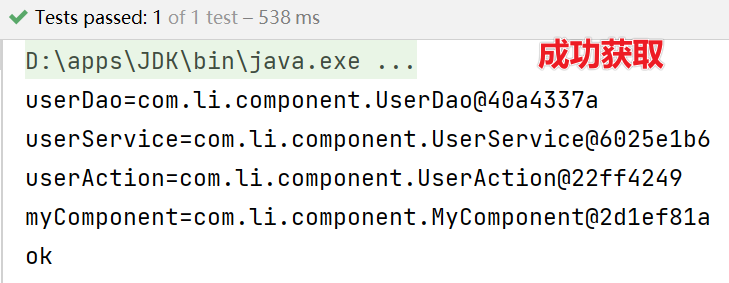
3.1.3註意事項和細節
-
基於註解配置bean,需要導入spring-aop.jar包
-
必須在Spring配置文件中指定“自動掃描的包”,IOC容器才能夠檢測到當前項目中哪些類被標識了註解
(1)在配置時註意導入context名稱空間
(2)指定掃描的包時,可以使用通配符,如:
com.li.component.*表示掃描com.li.component包下的類, 包括com.li.component包下的子包(遞歸掃描) -
Spring的IOC容器不能檢測一個使用了@Controller註解的類到底是不是一個真正的控制器。註解的名稱只是用於程式員自己識別當前標識的是什麼組件。其他的註解@Service、@Reposity 也是一樣。
也就是說,Spring的容器只要檢測到註解就會生成對象,但是這個註解的含義spring不會識別,只是給程式員方便區分的
如果你只在spring容器上用,@Controller、@Service、@Reposity基本是等價的;如果你用在springmvc上面,它們是有區別的:徹底弄懂@Controller 、@Service、@Component
-
配置只掃描滿足要求的類:
如下麵的resource-pattern="User*.class",表示掃描指定包下以User開頭的類
<context:component-scan base-package="com.li.component" resource-pattern="User*.class" />一般來說,想要掃描某個類只需要寫上註解,不想掃描的類就不會寫註解,因此上面這種寫法不常使用
-
配置排除掃描的類:
如果我們希望排除某個包/子包下的某種類型的註解,可以通過exclude-filter來指定
(1)context:exclude-filter 指定要排除哪些類
(2)type 指定排除方式(annotation 表示通過註解來排除)
(3)expression 指定要排除的註解的全路徑
下麵的配置表示,在掃描com.li.component包下註解的類時,排除以@Service註解的類
<context:component-scan base-package="com.li.component" > <!-- 排除哪些類, 以 annotaion註解為例(通過註解來排除) --> <context:exclude-filter type="annotation" expression="org.springframework.stereotype.Service"/> </context> -
自定義規則指定掃描哪些註解類:
<!--如果我們希望通過自己的規則,來掃描包/子包下的某些註解類,可以通過include-filter 1. use-default-filters="false": 表示不使用預設的過濾/掃描機制 2. context:include-filter: 表示只是掃描指定的註解的類 3. type="annotation" 表示按照註解方式來掃描 4. expression="org.springframework.stereotype.Controller" 指定要掃描的註解的全類路徑 --> <context:component-scan base-package="com.li.component" use-default-filters="false"> <context:include-filter type="annotation" expression="org.springframework.stereotype.Service"/> <context:include-filter type="annotation" expression="org.springframework.stereotype.Controller"/> </context:component-scan> -
在預設情況下,註解標識的類創建對象後,在容器中它預設對應的id就是它的類名(首字母小寫)
-
也可以使用註解的value屬性指定 id 值,並且 value 可以省略:
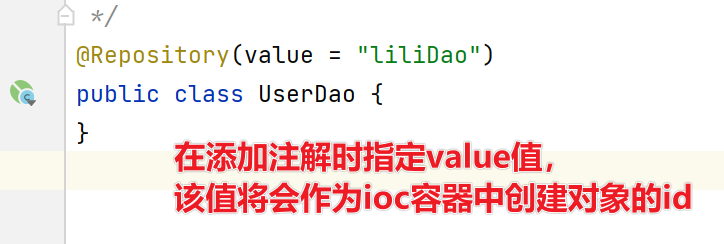

3.2手動開發-簡單的Spring基於註解配置的程式
3.2.1需求說明
自己寫一個簡單的Spring容器,通過讀取類的註解(@Component、@Controller、@Service、@Repository),將對象註入到IOC容器。即不使用Spring原生框架,我們自己使用IO+Annotation+反射+集合實現,加深對Spring註解方式開發的理解。
3.2.2思路分析
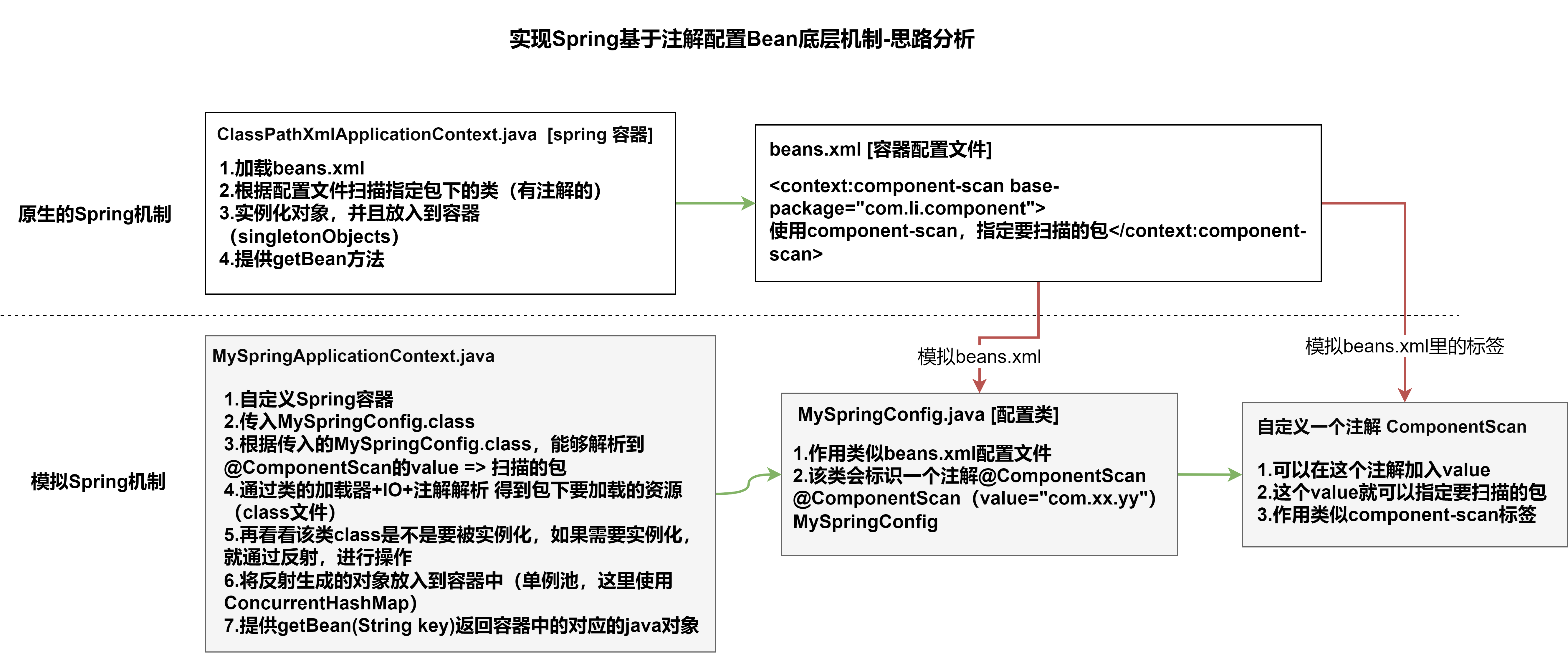
3.2.3代碼實現
步驟一.搭建基本結構並獲取掃描包
1.ComponentScan註解
package com.li.annotation;
import java.lang.annotation.ElementType;
import java.lang.annotation.Retention;
import java.lang.annotation.RetentionPolicy;
import java.lang.annotation.Target;
/**
* @author 李
* @version 1.0
* 模仿spring原生註解,自定義一個註解
* 1. @Target(ElementType.TYPE) 指定ComponentScan註解可以修飾TYPE元素
* 2. @Retention(RetentionPolicy.RUNTIME) 指定ComponentScan註解 的保留範圍
* 3. String value() default ""; 表示 ComponentScan 可以傳入一個value值
*/
@Target(ElementType.TYPE)
@Retention(RetentionPolicy.RUNTIME)
public @interface ComponentScan {
String value() default "";
}
2.MySpringConfig配置類
package com.li.annotation;
/**
* @author 李
* @version 1.0
* 這是一個配置類,作用類似我們原生spring的容器配置文件beans.xml
*/
@ComponentScan(value = "com.li.component")
public class MySpringConfig {
}
未完。。。



